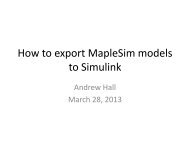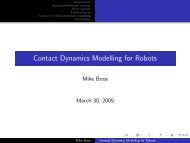Lecture notes on tire modelling - University of Waterloo
Lecture notes on tire modelling - University of Waterloo
Lecture notes on tire modelling - University of Waterloo
You also want an ePaper? Increase the reach of your titles
YUMPU automatically turns print PDFs into web optimized ePapers that Google loves.
An Introducti<strong>on</strong> to Tire Modelling<br />
for Multibody Dynamics Simulati<strong>on</strong><br />
SD 652<br />
Pr<strong>of</strong>essor John McPhee<br />
<strong>University</strong> <strong>of</strong> <strong>Waterloo</strong><br />
March 2013
Acknowledgement:<br />
Kevin Morency, Automatic Generati<strong>on</strong> <strong>of</strong><br />
Real-Time Simulati<strong>on</strong> Code for Vehicle<br />
Dynamics using Linear Graph Theory<br />
and Symbolic Computing, MASc Thesis,<br />
<strong>University</strong> <strong>of</strong> <strong>Waterloo</strong>, 2007
SAE Axis System
ISO Axis System
Rolling Resistance (M y )<br />
Produced by hysteresis in <strong>tire</strong> tread<br />
and sidewall rubber<br />
M y = (Fz)(δx)
Braking Force (F x )<br />
S = (V – wR) / V<br />
0 < S < 1
Braking Force (F x )<br />
S = (V – wR) / V<br />
0 < S < 1<br />
L<strong>on</strong>gitudinal Stiffness, C S , is the slope <strong>of</strong><br />
the F x vs. S curve at S=0
Driving Force (F x )<br />
S = (wR-V) / wR<br />
0 < S < 1
Lateral Force (F y ) and<br />
Aligning Moment (M z )
Lateral Force (F y ) and<br />
Aligning Moment (M z )<br />
Cornering Stiffness, C α , is the slope <strong>of</strong> the<br />
F y vs. α curve at α=0
Effect <strong>of</strong> Camber Angle (γ)<br />
<strong>on</strong> Lateral Force (F y )
Combined Slip (F x AND F y )
Overturning Moment (M x )
Characterizing a Pneumatic Tire:<br />
Physical Testing
Characterizing a Pneumatic Tire:<br />
Physical Testing
Data From Physical Tests<br />
C<strong>on</strong>sider how Fx varies with S: Fz, 20 and S,α, data S: γ : 20 20 points 24 =<br />
160 400 000 data data points points<br />
x5 = 800 000 data points
Tire Models:<br />
Mathematical Functi<strong>on</strong>s to Fit Measured Data<br />
Fiala: 6 parameters needed to describe a <strong>tire</strong><br />
•Easy to understand the physical significance <strong>of</strong> all parameters<br />
•Simple force and moment equati<strong>on</strong>s.<br />
•Does not handle combined slip<br />
•Effects <strong>of</strong> normal force and camber are largely ignored.<br />
Pacejka 2002 : 117 parameters needed<br />
•Very good fit to experimental data<br />
•More complicated force and moment equati<strong>on</strong>s
How Tire Forces are Included In<br />
Multibody Vehicle Model<br />
1. Define a point where <strong>tire</strong> forces and<br />
moments will act <strong>on</strong> the multibody model<br />
C2<br />
C1<br />
P<br />
2<br />
P<br />
1
How Tire Forces are Included In<br />
Multibody Vehicle Model<br />
2. Determine an expressi<strong>on</strong> for the vertical <strong>tire</strong><br />
force, Fz, which is required as an input to the<br />
<strong>tire</strong> model.
How Tire Forces are Included In<br />
Multibody Vehicle Model<br />
3. Establish vector directi<strong>on</strong>s for l<strong>on</strong>gitudinal<br />
and lateral comp<strong>on</strong>ents <strong>of</strong> <strong>tire</strong> force.
How Tire Forces are Included In<br />
Multibody Vehicle Model<br />
4. Determine kinematic inputs to <strong>tire</strong> model (S, γ, α)<br />
5. Use a <strong>tire</strong> model to calculate Fx, Fy, Mx, My, Mz
MapleSim Demo
The Fiala Tire Model<br />
The original <strong>tire</strong> model in MSC.ADAMS<br />
Inputs:<br />
1. Multibody model (mass, rotati<strong>on</strong>al inertia)<br />
2. Tire parameters (C s , C α , etc.)<br />
3. The current kinematic state (S, α ,γ, etc.)
Effect <strong>of</strong> Normal Force (F z )<br />
<strong>on</strong> Lateral Force (F y )











